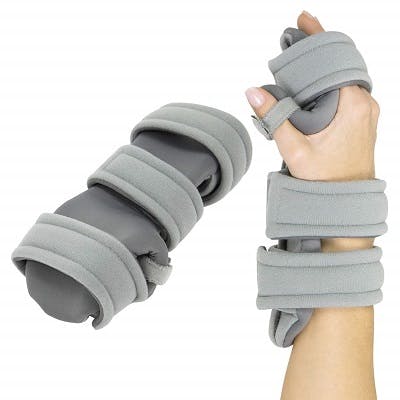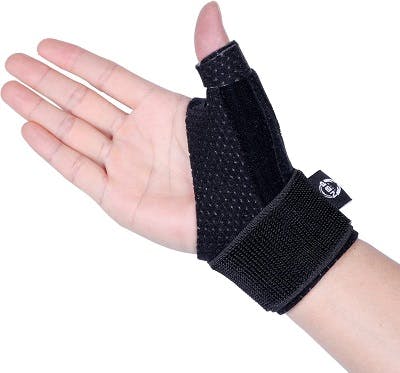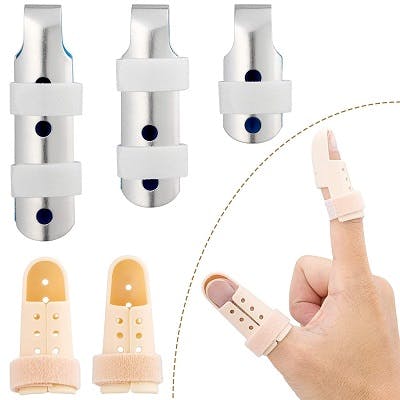Splinting can be helpful for spinal cord injury survivors that struggle with hand function. After a high level injury such as a cervical spinal cord injury the hands may become weak or paralyzed. If left unmanaged, further complications can develop. Fortunately, hand splints for spinal cord injury can help prevent deformity and promote functional hand positions.
While there are a variety of hand splints for spinal cord injury you can choose from, we’ve narrowed down some of the most effective and commonly prescribed by therapists. Before diving into the list, let’s take a look at the benefits of using hand splints and how to choose the right fit for you.
How a Spinal Cord Injury Can Affect Hand Function
A spinal cord injury can affect many different functions of the body, including hand function. For example, damage to the spinal cord can result in paralysis or immobility, depending on the severity and level of injury. The level of injury refers to the lowest region where movement and sensation exist.
If the injury was complete, meaning the spinal cord was fully severed, there is no movement or sensation above or below the level of injury. If the injury was incomplete, it means the spinal cord was partially severed and there are still some neural pathways remaining.
Many individuals may experience paraplegia (paralysis of the lower limbs) or quadriplegia (paralysis of the upper and lower limbs) after SCI. More specifically, survivors with a cervical spinal cord injury may experience loss of motor control in their neck, arms, and hands.
To compensate for weak or paralyzed muscles, survivors can use hand splints for spinal cord injury. Hand splints help support the integrity of the joints by maintaining their alignment and reducing any potential damage to the tissues.
Splints also help maintain the normal appearance of the hands by supporting the arches. However, to accomplish this, hand splints must be molded to fit the arches and creases of an individual’s hands.
The hands of a survivor with quadriplegia may be more prone to overstretching, stiffness, tightening, or contractures due to impaired muscle function. Fortunately, hand splints for spinal cord injury can help control and prevent further injury or serious deformities.
Types of Hand Splints for Spinal Cord Injury
A splint is an orthotic device that helps support the hand in an optimal position. Splints can either be dynamic, meaning they allow movement, or they can be static which means they are in a fixed position.
A splint is usually prescribed by an occupational therapist. Depending on the type of splint, they may recommend wearing it during the day, at night, or for a particular task. To help you find the best splint for your needs, we’ve compiled a list of the top hands splints for spinal cord injury. Ask your therapist to ensure it is safe and suitable for you.
The best hand splints for spinal cord injury include:
1. Resting Hand Splints

A resting splint is the most commonly used hand splint for spinal cord injury. It provides support to the whole hand and wrist and helps you extend up the forearm. It helps keep a hand in a functional position with the wrist, and also allows slight bending of the fingers. Once molded, it’s placed under the fingers and into the thumb web space.
However, the wrist and arm should be positioned carefully. Clinicians customize splint position based on tone, tenodesis grasp, and regaining active finger motion. A resting splint is usually worn throughout the night, with wearing tolerance increasing over a few days.
>>> Shop Resting Hand Splints on Amazon
2. Wrist Splints
The wrist splint is designed to maintain the wrist in a neutral position. The primary goal of a wrist splint is to prevent overstretching of the wrist extensors and provide a stable base. They also support the wrist in extension, allowing individuals to use their hands with assistive devices and perform activities such as eating, typing, and pushing a wheelchair.
To wear it, place the thumb into the cut-out. Metal struts are usually positioned on both sides of the wrist and must be tightened firmly to hold the position. Clinicians recommend wrist splints are worn during the day to increase functional activity participation.
>>> Shop Wrist Splints on Amazon
3. Short Opponens Splints

Short opponens splints help maintain web space, prevent hyperextension, and promote functional hand position. They are tailored to help individuals who have proper wrist extension but an imbalance between the extrinsic and intrinsic finger muscles. Short opponens splints also help facilitate tenodesis by opposing the thumb and preventing it from overstretching when performing tasks.
>>> Shop Short Opponens Splints on Amazon
4. Long Opponens Splints
Long opponens splints help maintain web space (area between the thumb and index finger) but are used less frequently than other splints. However, therapists recommended them for functional activities but to be mindful when using long opponens because they can interfere with wheelchair operation.
5. Tenodesis Splints
Tenodesis grasp and release is a mechanism that most individuals have naturally. When the wrist is bent downwards (flexed), the fingers straighten out and feel loose. When the wrist is bent upwards (extended), the fingers curl up together and form a grip. However, when a spinal cord injury impairs the hands it may affect this natural mechanism.
Tenodesis splints are designed to help tighten the soft tissues of the hands. They especially help individuals with wrist extensors who lack mobility in the fingers. Tenodesis splints are worn until desired “grip” has been achieved, usually alternating nightly.
6. Palmar-Dorsal Splints
After a spinal cord injury, the fingers and/or wrist may increase in tone due to reduced range of movement. Palmar-dorsal splints can provide the fingers and wrist with a stable stretch. Fingers are placed in the splint first, allowing them to gently stretch out.
Then the finger section goes onto the palm, with the forearm section on top of the arm. Lastly, the strap is placed under the arm to provide a pivot of support. Palmar-dorsal splints are designed to be worn regularly for extended periods of time.
7. Typing Splints
Typing splints are designed to help survivors use a keyboard. Typing on a computer can be challenging after a spinal cord injury, but typing hand splints help stabilize finger positions. Survivors can usually remove these splints using their teeth, making them easier to use. However, typing splints can only be used on a regular computer keyboard. To use other devices, different splints may be needed.
>>> Shop Typing Splints on Wright Stuff
8. Finger Splints

To use devices more freely after a spinal cord injury, survivors may benefit from using finger splints. These splints help stabilize the fingers while allowing the tips to be used such as for touch screen smartphones or tablets.
>>> Shop Finger Splints on Amazon
9. MCP Splints
Metacarpal-phalangeal blocking (MCP) splints help prevent hyperextension during functional hand tasks. They help redirect, isolate, and increase active motion in weak or stiff joints. Therapists may recommend MCP splints to block motion in an inflamed joint to help reduce pain.
10. Other Splints
Lastly, there are other hand splints for spinal cord injury that are commonly prescribed by therapists depending on the needs of every survivor. This can include more specific splints such as elbow extension splints, elbow pillow splints, anti-spasticity splints, and intrinsic plus or minus splints.
While many splints provide similar benefits, it’s important to find the best fit for you. Consult with your therapist to see what hand splints after spinal cord injury are most suitable for your goals. Splints can aid in your spinal cord injury recovery, but require the assistance of other therapies to maximize your chances of restoring function.
Hand Splints Combined With Therapy for Spinal Cord Injury
Hand splints are most effective when combined with therapeutic exercises for spinal cord injury. When a spinal cord injury damages the neural pathways used for communication between the brain and spinal cord, it can impair hand function. While in a complete spinal cord injury there may be no unaffected neural pathways remaining, an incomplete spinal cord injury usually does which means there is hope for recovery.
Existing neural pathways can be strengthened and new ones created with the help of neuroplasticity, the central nervous system’s ability to repair itself. However, neuroplasticity is best activated with high repetition of exercises, or massed practice. The more the central nervous system is stimulated, the more neuroplasticity can create and strengthen neural pathways needed to restore hand function.
Therefore, to improve movement and coordination, survivors must practice high repetition of hand exercises for spinal cord injury. Though only survivors with incomplete spinal cord injuries have neural pathways remaining, individuals with complete spinal cord injuries can still benefit from moving their hands through full range of motion on a regular basis.
Your therapist can also provide more guidance on which hand therapy exercises and hand splints are appropriate for you. The more you exercise your hands, the higher the chances of improving mobility and overall hand function.
Choosing the Best Hand Splints for Spinal Cord Injury
A spinal cord injury can impair various functions including the hands. Survivors may experience weakness, paralysis, or lack of mobility in the hands. Fortunately, hand splints for spinal cord injury can help survivors improve these conditions. Consult with your therapist to find the best hand splint for you.
We hope this article helped you understand the benefits of hand splints after spinal cord injury, and encouraged you to simultaneously practice hand exercises for higher chances of recovery.
The post Hand Splints for Spinal Cord Injury: How to Choose the Right Fit for You appeared first on Flint Rehab.



